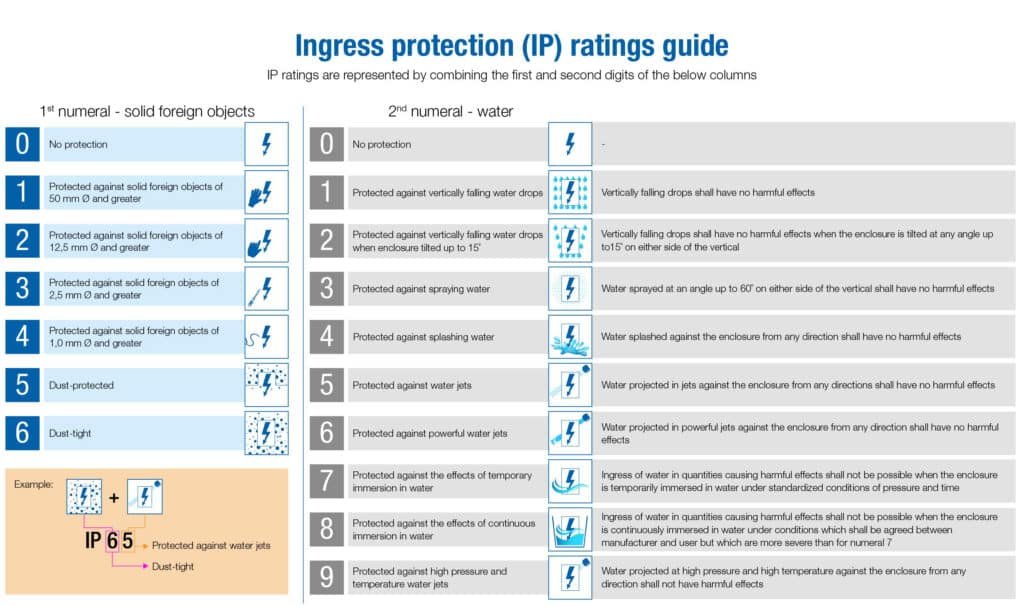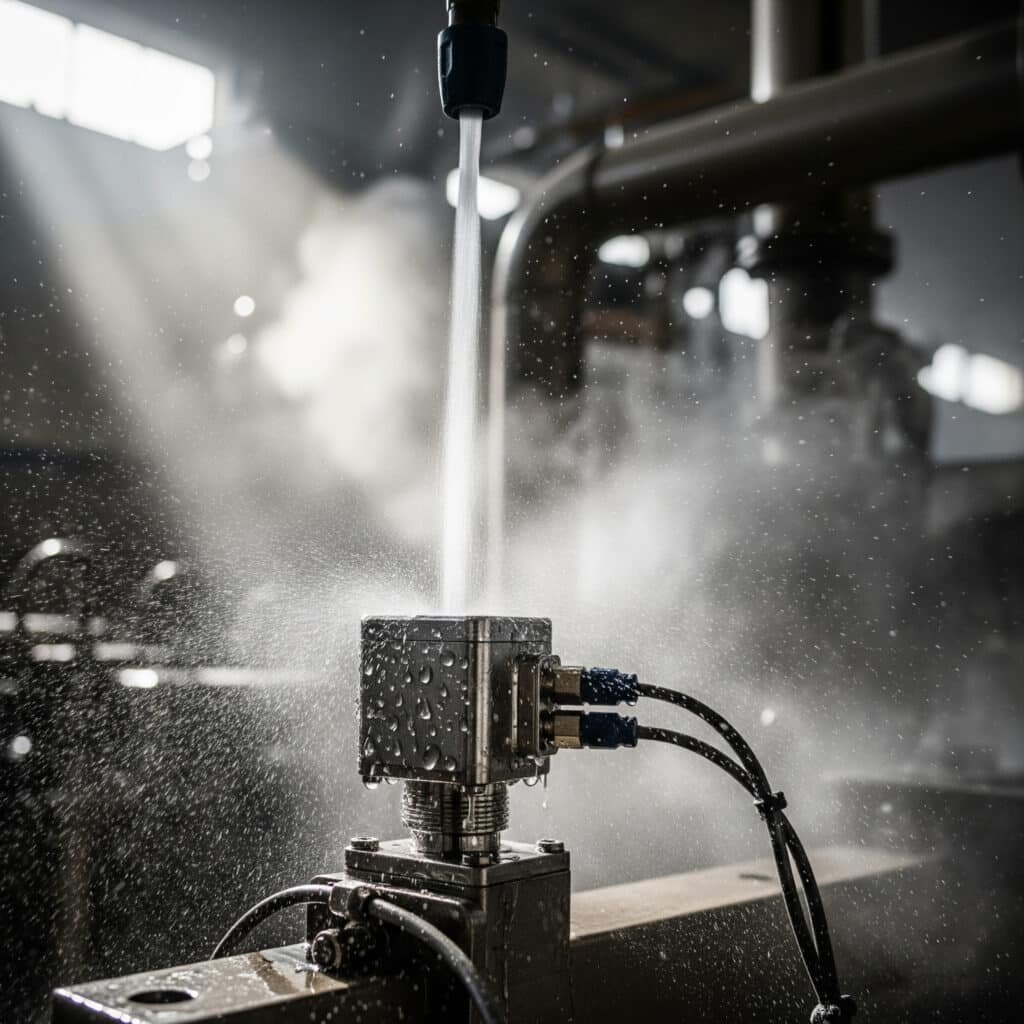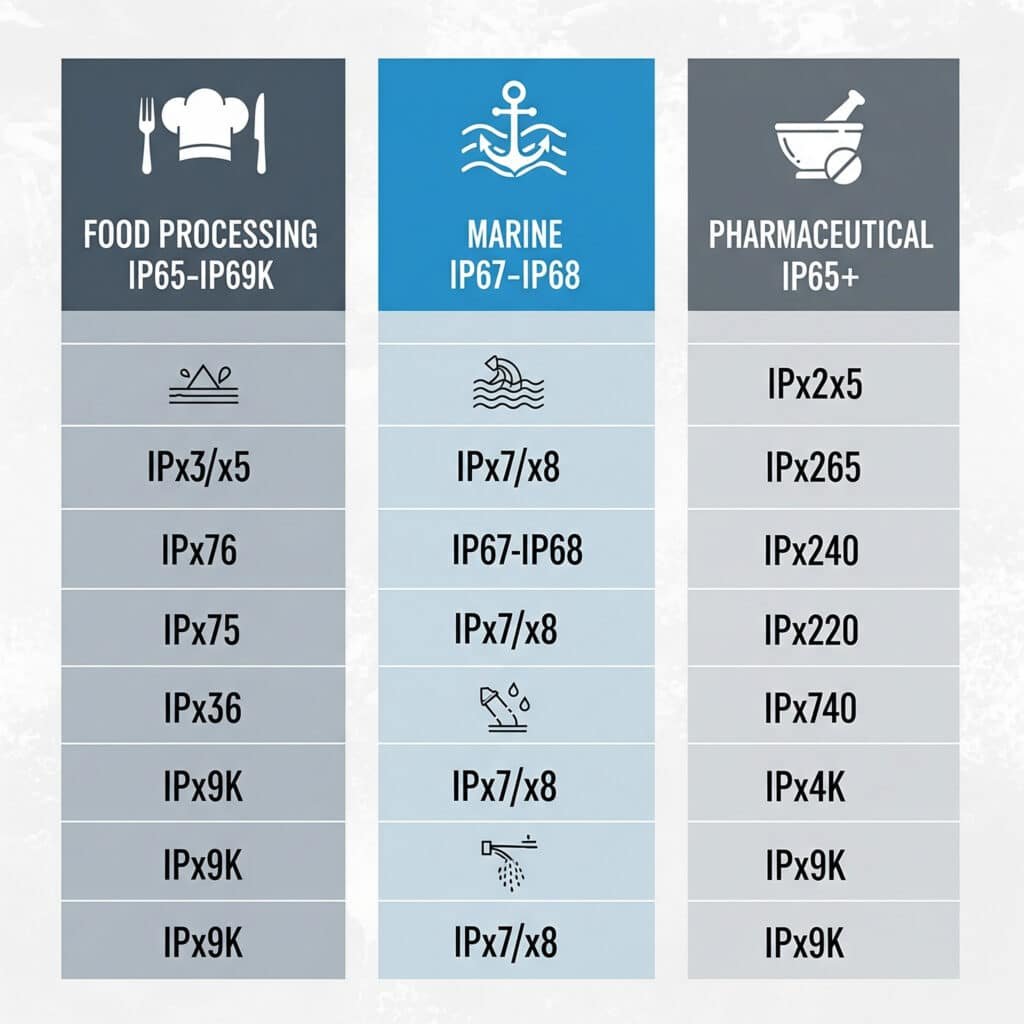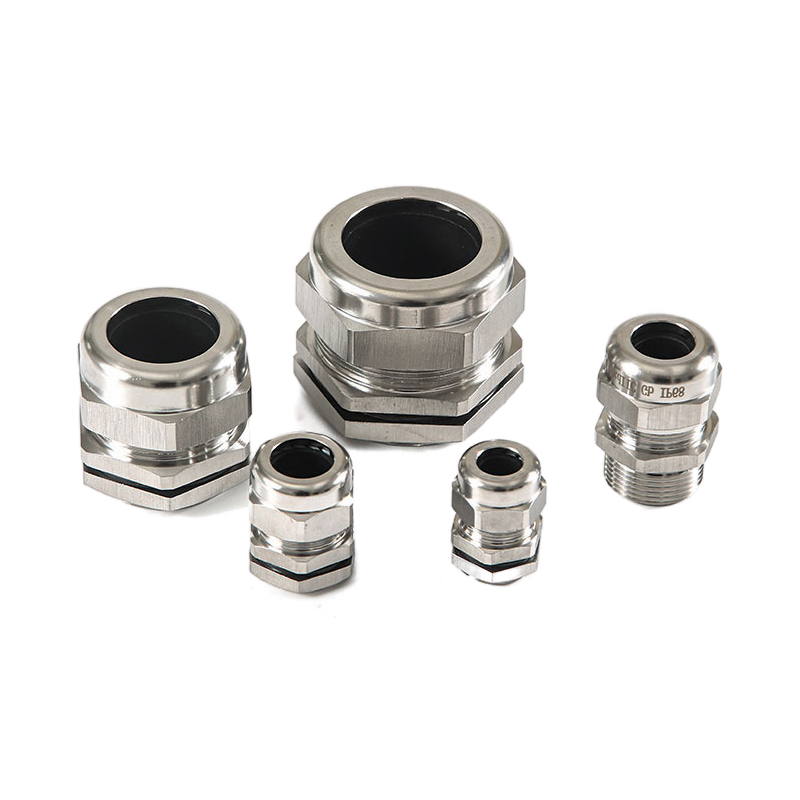Choosing the wrong IP rating can lead to equipment failure, safety hazards, and costly downtime in your electrical installations.
IP (Ingress Protection) ratings1 define specific protection levels against solid particles and liquids, with codes ranging from IP20 (basic dust protection) to IP68 (complete dust-tight and submersible protection) to help you select appropriate cable glands for your environment.
Last week, Hassan’s chemical plant avoided a $100,000 equipment failure by upgrading from IP65 to IP68 cable glands after we identified their washdown procedures required submersion-level protection.
Table of Contents
- What Do IP Rating Numbers Actually Mean in Real Applications?
- How Do You Match IP Ratings to Specific Environmental Conditions?
- Which IP Ratings Are Required for Different Industries and Applications?
- What Are the Most Common IP Rating Selection Mistakes to Avoid?
What Do IP Rating Numbers Actually Mean in Real Applications?
Understanding IP codes goes beyond memorizing numbers – it’s about matching protection levels to real-world conditions.
IP ratings use a two-digit system where the first digit (0-6) indicates solid particle protection from large objects to dust-tight sealing, while the second digit (0-9) specifies liquid protection from vertical drips to high-pressure jets and submersion.

Complete IP Rating Chart
First Digit – Solid Particle Protection:
| Rating | Protection Level | Test Object | Real-World Meaning | Typical Applications |
|---|---|---|---|---|
| 0 | No protection | – | Open to all particles | Indoor, clean environments only |
| 1 | >50mm objects | Back of hand | Large body parts, tools | Basic indoor panels |
| 2 | >12.5mm objects | Finger | Fingers, small tools | Standard electrical enclosures |
| 3 | >2.5mm objects | Wire/tool | Wires, screwdrivers | Outdoor junction boxes |
| 4 | >1mm objects | Wire/screw | Small wires, screws | Industrial environments |
| 5 | Dust protected | Dust | Limited dust ingress | Dusty industrial areas |
| 6 | Dust tight | Fine dust | Complete dust exclusion | Harsh industrial, marine |
Second Digit – Liquid Protection:
| Rating | Protection Level | Test Method | Real-World Conditions | Application Examples |
|---|---|---|---|---|
| 0 | No protection | – | Dry locations only | Indoor control rooms |
| 1 | Vertical drips | 1mm/min for 10min | Condensation, light moisture | Standard indoor use |
| 2 | Drips at 15° | Tilted 15° from vertical | Slight water ingress | Sloped installations |
| 3 | Spraying water | 60° from vertical | Rain, sprinkler systems | Outdoor equipment |
| 4 | Splashing water | All directions | Water splashing | Washdown areas |
| 5 | Water jets | 6.3mm nozzle, 12.5L/min | Hose cleaning | Food processing |
| 6 | Powerful jets | 12.5mm nozzle, 100L/min | High-pressure washing | Marine, heavy industry |
| 7 | Temporary immersion | 1m depth, 30min | Flooding, temporary submersion | Flood-prone areas |
| 8 | Continuous submersion | >1m depth, continuous | Permanent underwater | Underwater installations |
| 9 | High-pressure/temperature | Steam cleaning | Steam jets, high-pressure wash | Automotive, food industry |
Practical Translation Examples
When David asked about IP54 vs IP65 for his outdoor motor control panels, here’s how I explained it:
IP54 (Dust Protected + Splash Resistant):
- Reality: Some dust may enter but won’t harm operation
- Water: Protected against rain and splashing
- Best for: Covered outdoor installations, light industrial
IP65 (Dust Tight + Jet Resistant):
- Reality: No dust ingress whatsoever
- Water: Withstands direct hose washing
- Best for: Exposed outdoor use, washdown environments
The key difference? IP65 costs 30% more but prevents the maintenance headaches David experienced with his previous IP54 installations! 😉
How Do You Match IP Ratings to Specific Environmental Conditions?
Environmental assessment is crucial for selecting appropriate IP protection levels without over-specifying.
Effective IP rating selection requires analyzing dust levels, moisture exposure, cleaning requirements, temperature variations, and maintenance access to determine the minimum protection level that ensures reliable operation throughout the equipment’s service life.

Environmental Assessment Matrix
Dust Environment Analysis:
| Environment Type | Dust Characteristics | Minimum IP Rating | Cable Gland Considerations |
|---|---|---|---|
| Clean Indoor | Minimal airborne particles | IP2X | Standard sealing adequate |
| Light Industrial | Occasional dust, lint | IP4X | Basic dust protection |
| Heavy Industrial | Continuous dust exposure | IP5X | Enhanced sealing systems |
| Extreme Dusty | Cement, mining, sandblasting | IP6X | Complete dust exclusion |
Moisture Exposure Evaluation:
| Moisture Source | Exposure Level | Required Rating | Special Considerations |
|---|---|---|---|
| Condensation | Light, occasional | IPX1-IPX2 | Ventilation important |
| Rain/Weather | Moderate, seasonal | IPX3-IPX4 | Drainage design critical |
| Washdown | Regular, directed | IPX5-IPX6 | Chemical compatibility |
| Submersion | Continuous/temporary | IPX7-IPX8 | Pressure considerations |
Industry-Specific Environmental Challenges
Food Processing Facilities:
Hassan’s food plant required IP69K cable glands due to:
- High-pressure steam cleaning: 80°C, 8-10 MPa pressure
- Chemical sanitizers: Aggressive cleaning agents
- Temperature cycling: -20°C freezers to +60°C cooking areas
- Regulatory compliance: FDA, USDA requirements
Marine Applications:
- Salt spray exposure: Continuous corrosive environment
- Wave action: Intermittent submersion
- UV radiation: Gasket degradation concerns
- Vibration: Constant motion and shock loads
Mining Operations:
- Abrasive dust: Silica, coal, metal particles
- Explosive atmospheres: ATEX/IECEx requirements
- Extreme temperatures: -40°C to +60°C variations
- Chemical exposure: Processing chemicals, acids
Selection Decision Tree
Step 1: Dust Assessment
- Clean environment → IP2X minimum
- Light dust → IP4X recommended
- Heavy dust → IP5X required
- Extreme dust → IP6X mandatory
Step 2: Water Exposure
- Dry indoor → IPX0 acceptable
- Condensation risk → IPX2 minimum
- Outdoor exposure → IPX4 recommended
- Washdown areas → IPX5-IPX6 required
- Submersion risk → IPX7-IPX8 mandatory
Step 3: Special Conditions
- High-pressure cleaning → IP69K
- Explosive atmosphere → ATEX compliance
- Extreme temperatures → Material compatibility
- Chemical exposure → Gasket selection critical
Cost-Benefit Analysis
Over-Specification Costs:
- 20-50% higher material costs
- Increased installation complexity
- Potential maintenance difficulties
- Unnecessary feature premium
Under-Specification Risks:
- Equipment failure and replacement
- Unplanned downtime costs
- Safety hazards and liability
- Maintenance frequency increases
David learned this balance when we right-sized his installation from IP68 to IP65, saving 40% on cable gland costs while maintaining required protection levels.
Which IP Ratings Are Required for Different Industries and Applications?
Industry standards and regulations often dictate minimum IP rating requirements for safety and reliability.
Food processing typically requires IP65-IP69K for washdown areas, marine applications need IP67-IP68 for salt spray resistance, while pharmaceutical cleanrooms require IP65 minimum with additional contamination controls for maintaining sterile environments.

Industry-Specific Requirements
Food & Beverage Processing:
| Application Area | Minimum IP Rating | Special Requirements | Cable Gland Features |
|---|---|---|---|
| Dry processing | IP54 | Dust control | Standard sealing |
| Wet processing | IP65 | Washdown capability | Chemical-resistant gaskets |
| CIP systems | IP67 | Chemical compatibility | 316L stainless steel |
| Steam cleaning areas | IP69K | High temperature/pressure | Specialized seals |
Pharmaceutical Manufacturing:
- Cleanroom Class C/D: IP65 minimum
- Sterile processing: IP67 with validation protocols
- Wash-in-place (WIP): IP69K for cleaning validation
- Material requirements: USP Class VI2 compliant elastomers
Marine & Offshore:
| Environment | IP Rating | Additional Standards | Material Selection |
|---|---|---|---|
| Deck equipment | IP67 | Salt spray resistance | 316L stainless steel |
| Engine rooms | IP65 | Oil/fuel resistance | Viton gaskets |
| Underwater | IP68 | Pressure rating | Specialized compounds |
| Explosive zones | IP65 + ATEX | Zone classification | Certified assemblies |
Chemical Processing:
Hassan’s petrochemical facility specifications:
- General areas: IP65 minimum
- Hazardous zones: IP65 + ATEX Zone 1/2
- Corrosive environments: 316L stainless steel housing
- High-temperature areas: Viton seals, extended temperature range
Regulatory and Standards Framework
International Standards:
- IEC 60529: Defines IP rating test methods
- EN 60529: European harmonized standard
- NEMA 2503: North American enclosure ratings
- JIS C 0920: Japanese industrial standard
Industry-Specific Codes:
- FDA 21 CFR: Food contact surface requirements
- 3-A Sanitary Standards4: Dairy equipment specifications
- EHEDG Guidelines5: European hygienic equipment design
- ATEX Directive: Explosive atmosphere protection
Regional Variations:
- Europe: EN standards mandatory for CE marking
- North America: UL/CSA listings required
- Asia-Pacific: Mix of IEC and local standards
- Middle East: Often dual certification requirements
Application-Specific Selection Guide
Outdoor Installations:
- Standard outdoor: IP54 minimum (rain protection)
- Exposed locations: IP65 recommended (jet resistance)
- Coastal areas: IP67 + corrosion resistance
- Flood-prone areas: IP68 submersion protection
Indoor Industrial:
- Clean environments: IP20-IP40 adequate
- Dusty conditions: IP54-IP65 depending on severity
- Washdown areas: IP65-IP67 required
- Cleanrooms: IP65 + special validation
Transportation:
- Railway rolling stock: IP65 + fire resistance
- Marine vessels: IP67 + vibration resistance
- Automotive: IP67 + temperature cycling
- Aviation: IP65 + altitude/pressure considerations
Compliance Documentation
Required Certifications:
We ensure all our cable glands include:
- IP rating test certificates from accredited laboratories
- Material compliance documents for food/pharma applications
- ATEX/IECEx certificates for hazardous areas
- Corrosion resistance data for marine environments
Traceability Requirements:
- Batch tracking for pharmaceutical applications
- Material certificates for food contact surfaces
- Calibration records for test equipment
- Installation and maintenance documentation
What Are the Most Common IP Rating Selection Mistakes to Avoid?
Even experienced engineers make critical IP rating errors that compromise system reliability and safety.
The most frequent mistakes include assuming higher ratings are always better, ignoring dynamic sealing requirements, misunderstanding test conditions versus real-world exposure, and failing to consider long-term gasket degradation in harsh environments.
Top 10 Selection Mistakes
1. Over-Specifying IP Ratings
David’s first project specified IP68 for all outdoor applications, increasing costs by 60%. We analyzed actual conditions and found IP65 met requirements perfectly.
Common error: “Higher rating = better protection”
Reality: IP68 may trap moisture if not truly submersible
Solution: Match rating to actual environmental conditions
2. Ignoring Dynamic vs. Static Conditions
Static testing: Laboratory conditions with stationary equipment
Dynamic reality: Vibration, thermal cycling, pressure changes
Impact: Seals that pass static tests may fail in service
Our approach: Specify enhanced gasket retention for dynamic applications
3. Misunderstanding Test Duration
IP67 test: 30 minutes at 1-meter depth
Real application: Continuous submersion for years
Problem: Test doesn’t guarantee long-term performance
Solution: Consider IP68 for permanent submersion applications
4. Temperature Effects on Sealing
Hassan’s desert installation failed because standard gaskets hardened at 70°C ambient temperatures.
Common oversight: Ignoring temperature impact on elastomers
Consequences: Seal failure, loss of IP protection
Prevention: Specify temperature-rated gasket materials
Our recommendation: EPDM or Viton for extreme temperatures
5. Chemical Compatibility Ignorance
Problem: Standard NBR gaskets degraded in cleaning chemicals
Result: Complete seal failure within six months
Solution: Chemical compatibility testing before specification
Best practice: Material selection based on actual chemical exposure
Installation-Related Mistakes
6. Improper Torque Application
Under-torquing: Inadequate seal compression, IP rating loss
Over-torquing: Gasket extrusion, thread damage
Solution: Follow manufacturer torque specifications exactly
Our tools: Calibrated torque wrenches for field installation
7. Gasket Damage During Installation
Common causes: Sharp edges, contamination, improper handling
Prevention: Clean installation practices, proper tools
Inspection: Visual verification before final assembly
Documentation: Installation checklists and photos
8. Mixing Thread Standards
Problem: NPT threads in metric enclosures
Result: Improper fit, compromised sealing
Prevention: Verify thread compatibility before ordering
Our service: Thread verification and conversion recommendations
Long-Term Performance Mistakes
9. Ignoring Maintenance Requirements
Assumption: “Install and forget” mentality
Reality: Gaskets age, seals degrade over time
Consequence: Gradual IP rating degradation
Solution: Preventive maintenance schedules
Our support: Maintenance training and spare parts programs
10. Environmental Change Oversight
Scenario: Plant expansion changes environmental conditions
Problem: Original IP ratings no longer adequate
Example: Adding washdown procedures to dry processing area
Solution: Regular environmental reassessment
Recommendation: Design flexibility for future changes
Quality Verification Strategies
Pre-Installation Testing:
- Visual inspection: Gasket condition, thread integrity
- Fit verification: Proper cable diameter compatibility
- Torque testing: Calibrated installation procedures
- Documentation: Complete installation records
Post-Installation Validation:
- Pressure testing: Verify seal integrity where applicable
- Insulation testing: Electrical safety verification
- Environmental monitoring: Confirm protection effectiveness
- Performance tracking: Long-term reliability assessment
Ongoing Monitoring:
- Regular inspections: Visual checks for degradation
- Gasket replacement: Scheduled preventive maintenance
- Environmental changes: Reassess when conditions change
- Performance documentation: Track failure modes and improvements
Cost-Effective Solutions
Right-Sizing Strategies:
- Zone-based selection: Different IP ratings for different areas
- Phased upgrades: Improve protection where needed most
- Bulk purchasing: Volume discounts for standard ratings
- Standardization: Reduce inventory with common specifications
David’s facility now uses our zone-based approach: IP54 for covered areas, IP65 for exposed locations, and IP67 only where washdown occurs. This reduced overall costs by 35% while maintaining proper protection levels.
Conclusion
Proper IP rating selection requires understanding both the technical specifications and real-world environmental conditions to ensure reliable, cost-effective protection.
FAQs About IP Rating Selection for Cable Glands
Q: Is IP68 always better than IP67 for outdoor applications?
A: Not necessarily. IP68 is designed for continuous submersion, while IP67 handles temporary immersion. For standard outdoor use with occasional flooding, IP67 is often more appropriate and cost-effective. IP68 may actually trap moisture if the application doesn’t truly require submersion protection.
Q: Can I use IP65-rated cable glands in an IP67-rated enclosure?
A: The overall system IP rating is limited by the lowest-rated component. Using IP65 glands in an IP67 enclosure reduces the system rating to IP65. However, this might be acceptable if the actual environmental conditions only require IP65 protection, potentially saving costs.
Q: How often should IP-rated cable glands be inspected or replaced?
A: Inspection frequency depends on environmental severity – annually for standard outdoor applications, quarterly for harsh chemical environments. Gasket replacement is typically needed every 3-5 years for standard conditions, or sooner if degradation is observed during inspection.
Q: Do higher IP ratings require special installation procedures?
A: Yes, higher IP ratings typically require more precise installation procedures, including specific torque values, gasket positioning, and contamination prevention. IP67 and IP68 installations especially require careful attention to seal integrity and proper thread engagement.
Q: What’s the difference between IP69K and IP68 ratings?
A: IP69K is specifically designed for high-pressure, high-temperature cleaning (steam cleaning), while IP68 focuses on submersion protection. Food processing and automotive applications often require IP69K, while marine and underground applications typically need IP68. They address different environmental challenges.
-
Review the official IEC 60529 standard that defines the Ingress Protection (IP) rating system. ↩
-
Understand the stringent biocompatibility testing requirements for plastics under the USP Class VI classification. ↩
-
Learn about the NEMA 250 standard and the different enclosure type ratings used in North America. ↩
-
Explore the official 3-A Sanitary Standards for the design of food processing and dairy equipment. ↩
-
Discover the hygienic design criteria and guidelines from the European Hygienic Engineering & Design Group (EHEDG). ↩



